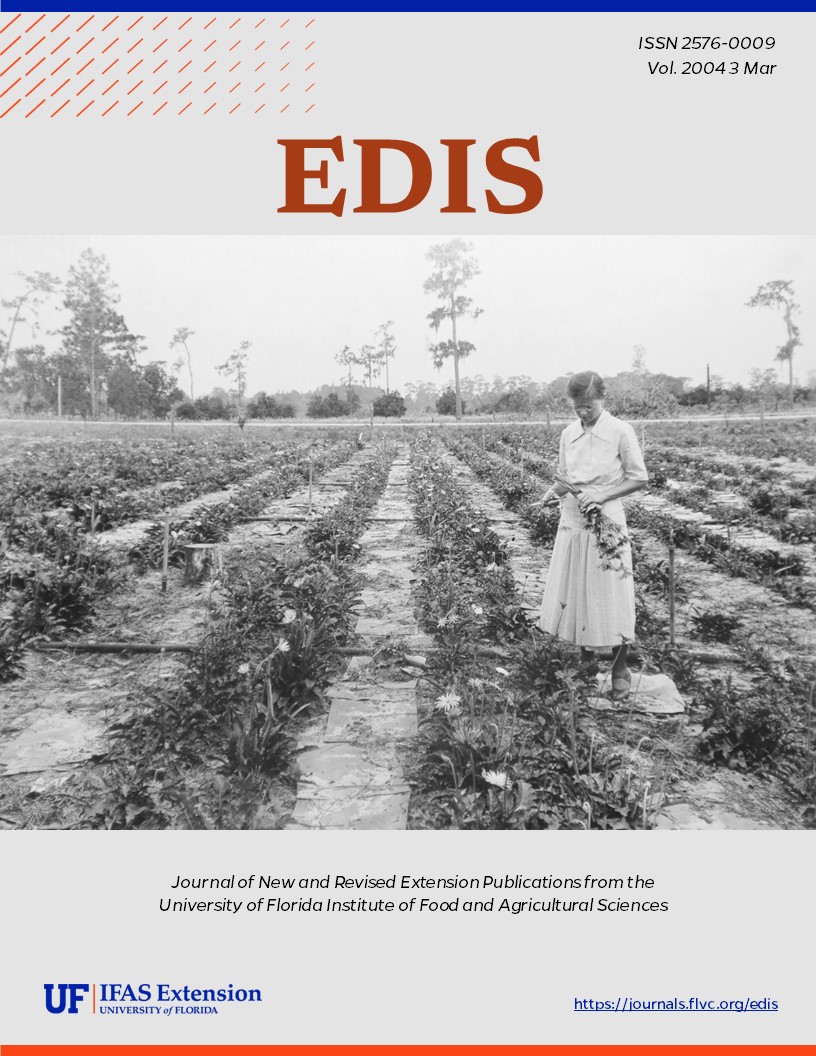Abstract
Xylopsocus capucinus (Fabricius) has previously been intercepted at ports of entry into the U.S. on many occasions in a wide variety of plant materials. However, Fisher (1950) stated that it "has not become established in the United States." On 14 March 1978, specimens were collected from cassava branches at Homestead, Florida, by J. Peña, and subsequent surveys indicate that the species is definitely established as a part of the Florida fauna. This document is EENY-179 (originally published as DPI Entomology Circular 195), one of the Featured Creatures series of the Entomology and Nematology Department, Cooperative Extension Service, Institute of Food and Agricultural Sciences, University of Florida. Published: December 2000.
References
Anonymous. 1978. A bostrichid beetle (Xylopsocus capucinus (Fabricius)). Coop. Plant Pest Rept. 3: 177.
Beeson, C.F.C., and B.M. Bhatia. 1937. On the biology of the Bostrychidae (Coleoptera). Indian Forest Rec. 2: 223-320.
Blackwelder, R.E. 1945. Checklist of the coleopterous insects of Mexico, Central America, the West Indies, and South America. U.S. Nat. Mus. Bull. 185, Part 3: 400. https://doi.org/10.5479/si.03629236.185.3
d'Araujo e Silva, A.G., C.R. Gonçalves, D.M. Galvao, A.J.L. Gonçalves, J. Gomes, M. do N. Silva, and L. de Simoni. 1968. Quarto catalogo dos insectos que vivem nas plantas do Brasil seus parasites e predadores. Pt. 2. Vol. 1: xiv + 622 p.
Fabricius, J.C. 1781. Species insectorum. 1: 1-552; Kilonii (Apate capucinus p. 62).
Fisher, W.S. 1950. A revision of the North American species of beetles belonging to the family Bostrichidae. USDA Misc. Publ. 698: 1-157 (Xylopsocus capucinus p. 140-141). https://doi.org/10.5962/bhl.title.65663
Gardner, J.C.M. 1933. Immature stages of Indian Coleoptera (13) (Bostrychidae). Indian For. Res., Ent. Ser. 18: 1-19.
Guagliumi, P. 1966 [1967]. Insetti e arachnidi delle piante comuni del Venezuela segnalati nel periodo 1938-1963. Relazioni e monographie agrarie subtropicale e tropicali (n.s.) 68: i- xix, 1-391.
Kalshoven, L.G.E. 1963a. Ecological data on some Neotropical Scolytidae, Platypodidae, and Bostrychidae (Coleoptera) mainly of Surinam. Beaufortia 9: 232-240.
Kalshoven, L.G.E. 1963b. Notes on the biology of Indonesian Bostrychidae (Coleoptera). Ent. Berichten 23: 242-257.
Kingsolver, J.M. 1971. A key to the genera and species of Bostrichidae commonly intercepted in USDA plant quarantine inspections. Agr. Quar. Insp. Memo (USDA) 697: 1- 11.
Lesne, P. 1900 [1901]. Revision des Coleopteres de la famille des Bostrychides. 4th Mem. Ann. Soc. Ent. France 69: 473-639.
Marin Acosta, J.C. 1975. Plagas de insectos en algunos frutales de importancia economica en Venezuela. Bol. Techn. (Publ. Fondo de Desarrollo Fruticola) 3: 1-73.
Miller, N.C.E. 1934. Coleopterous pests of stored Derris in Malaya. Dept. Agr. Straits Settlements Federated Malay States, Sci. Ser. 14: 1-34.
Spilman, T.J. 1971. Bredin-ArchboldSmithsonian biological survey of Dominica: Bostrichidae, Inopeplidae, Lagriidae, Lyctidae, Lymexylonidae, Melandryidae, Monommidae, Rhipiceridae, and Rhipiphoridae (Coleoptera). Smithsonian Contr. Zool. 70: 1-10. https://doi.org/10.5479/si.00810282.70
Stebbing, E.P. 1914. Indian forest insects of economic importance. Coleoptera. London, Eyre & Spottiswoode, Ltd. 648 p. https://doi.org/10.5962/bhl.title.9203
This work is licensed under a Creative Commons Attribution-NonCommercial-NoDerivs 4.0 International (CC BY-NC-ND 4.0) license.

